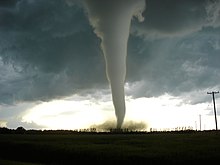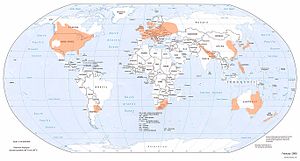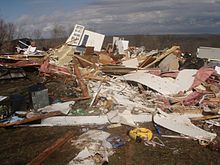Tornado myths
[1][7] Current advice is that opening windows in advance of a tornado wastes time that could be spent seeking shelter.
Many overpasses are completely exposed underneath and most lack hanging girders or a crawlspace-like area to provide sufficient protection from debris, which can travel at high speeds even in weak tornadoes.
An interior room inside a well-built frame house (especially one with a basement) provides a reasonable degree of protection from all but the most violent tornadoes.
Underground tornado shelters, as well as extremely strong structures such as bank vaults, offer almost complete protection.
[17] This situation would be magnified greatly if all the residents of a warned area left in their vehicles, which would cause traffic jams and accidents as the tornado approached.
[17] Numerous victims of the deadly Wichita Falls, Texas tornado on April 10, 1979, died in their vehicles in such a situation.
[18] Despite being considered "weak" on the Enhanced Fujita scale, EF0 and EF1 tornadoes can be a source of significant injuries or even deaths.
[21] On March 31, 2023 alone, an EF1 tornado struck the Apollo Theatre of Belvidere, Illinois, causing the building to collapse onto a sold-out concert, resulting in one fatality and 48 injuries,[22] and another EF1 tornado struck urban areas of Tupelo, Mississippi, destroying a Cooper Tire & Rubber Company plant and resulting in over $100,000,000 in damage.
[23] Several different phenomena have lent credence to the idea that tornadoes "skip" houses, like a person jumping over hurdles.
These discontinuities tend to occur over areas larger than the small neighborhoods where the house-skipping effect is observed, except possibly at the time of the birth and organization of the tornado.
Furthermore, a tornado is sometimes believed to be on the ground only when its condensation funnel descends to the surface, but this assumption is misleading and extremely dangerous.
The 2013 El Reno tornado is one such example which disproves both beliefs, as it featured an expansive and translucent outer circulation with an incomplete condensation funnel.
Spotters should keep sight of swirling debris directly under any visible funnel or rotating wall cloud, even if such structures appear to not descend entirely to the ground.
A deadly F5 tornado that hit the city of Jarrell, Texas, in 1997 moved to the southwest – directly opposite to the commonly expected storm motion.
[39] There are many misconceptions involving the effect of terrain features – bodies of water, mountains, valleys, and others – on tornado formation and behavior.
[26] In 1944, a violent tornado cut a continuous path at least 60 miles (97 km) through heavily forested and mountainous territory in West Virginia, killing at least 100 people.
[44] A hill known as Burnett's Mound on the southwest end of Topeka, Kansas was purported to protect the city from tornadoes, according to an old legend.
However, in 1966, an F5 tornado passed directly over the hill through downtown, killing 18 people and causing $100 million (1966 USD) in damage.
This myth continues to persist, and was further compounded by the fact that Burnett's Mound was rumored to be a burial ground of the Kansa Tribe, and that Topekans had committed sacrilege by attempting to build a water tower on the grounds immediately prior to the 1966 F5 tornado, despite strong opposition as a result of the myth.
[45] Downtown Memphis, Tennessee, was believed by residents to be protected from tornadoes and other severe weather by the Chickasaw Bluff along the Mississippi River.
[47] The 2023 Little Rock tornado tracked over significant uneven terrain over its life, with the most intense damage being recorded in a low point geographically in its path.
More people are killed in trailer parks because mobile homes are less able to withstand high winds than permanent structures.
Winds which can demolish or roll a mobile home may only cause roof damage to a typical one- or two-family permanent residence.
[51] Another likely contributing factor to the continued propagation of this myth is confirmation bias: whenever a new instance of a tornado hitting a mobile home park occurs, media outlets report on it more extensively, ignoring damage to the surrounding area which may not have produced as many casualties.
This does not apply to significant tornadoes, however, and it is possible that the presence of tall buildings may actually intensify storms which move into downtown areas.
[55] However, nuclear facilities in the United States are built to withstand winds upwards of 250 mph (400 km/h), and minimal damage to the reactors themselves was noted in both instances.
[58] For instance, the violent and deadly 2021 Western Kentucky tornado formed on the evening of December 10, well into meteorological winter, and maintained a consistent forward speed of 60 mph (97 km/h), killing 57 and injuring over 500.







